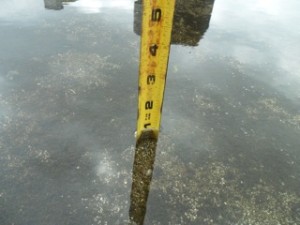THINK STANDING WATER ISN’T A PROBLEM? THINK AGAIN.

Standing water is defined as any water on a roof that hasn’t drained or dissipated within 48 hours after rainfall or other precipitation. If water hasn’t drained itself from your roof within 48 hours, chances are it will stay for an extended period of time. Once the standing water has been on the roof for a while, it begins to cause the roof to sag and creates a larger pool to hold more standing water. This further exacerbates the standing water problem. Once you have standing water, it typically creates a vicious cycle that ends with roof repairs or replacement to nullify the damage. If your roof has been damaged by standing water and needs to be replaced, check out the replacement options available to you.
So what does standing water do to your roof?
As standing water increases on your roof, the weight your roof must bear also increases. If the problem is not attended to, the standing water will likely exceed the designed weight threshold of the roof and potentially end in collapse. Standing water weighs approximately 5 lbs. per inch, per square foot of roof surface. A standing water area of only 10’ by 10’ and 1” deep is 200 total square feet and an additional live roof weight of 1,000 pounds. That can be extremely dangerous for your roof if too much water accumulates. This is the greatest risk you take if you don’t prevent standing water on your roof: collapses that damage equipment, inventory, and worst of all, could take lives. Another impact standing water can have on your roof is increased leaks. A typical roof with an appropriate slope may have many pinhole imperfections in the roofing surface. These holes go completely through the roof surface, yet no leak results. Why are there holes but no leaks? Because the roof is sloped and water is running off the roof. As the water runs, it isn’t searching for tiny pinholes through which it can reach the ground, it simply keeps moving along the surface of the roof. However, once the water stops running and is standing on the roof, it now has enough weight and downward pressure to force it into those pinholes. Once these pinholes become active leaks, there is now water leaking into the building beneath the pinholes.
What can you do about standing water on your roof?
Solar Powered Pumps
If you’ve got standing water, there are a few things you can and should do to fight it. The first remedy is comparable to a Band-Aid for a cut, in that it doesn’t fix the problem, but covers it up. However, if you’re looking for an inexpensive, temporary solution, a solar powered roof pump may be the answer for you. These pumps will get the standing water off your roof until you can invest in full-on repairs.
Check Your Roofing Fixtures
By searching the roof surface for leaking AC units, coolers, drain lines, or other common leaking roof fixtures, you can repair those items that are adding more water to the roofing system. You can’t simply fight the natural precipitation; you have to also look at what water you are adding to the roof surface yourself. You should also examine all drain areas and make sure that no roof debris or past roof patching material has become lodged in the drains. You may also find that granulated roofs have loose granules lodged in the drains. If they are clogged, you can expect standing water.
Roof Repairs
You can consult a professional roofer and see what they suggest. They will most likely recommend repitching the roof, install crickets to redirect the water, or install additional drains into the roof surface. If you do elect to perform roof repairs, make sure you utilize the services of a professional roofer. If you have standing water on your roof, be sure you take care of it sooner rather than later. Even if you can’t invest in full-on repairs, you should utilize some temporary methods such as pumps or plaster in the sunken roof area. Standing water can be dangerous for your building and those inside of it, and it’s better to be safe than sorry.
